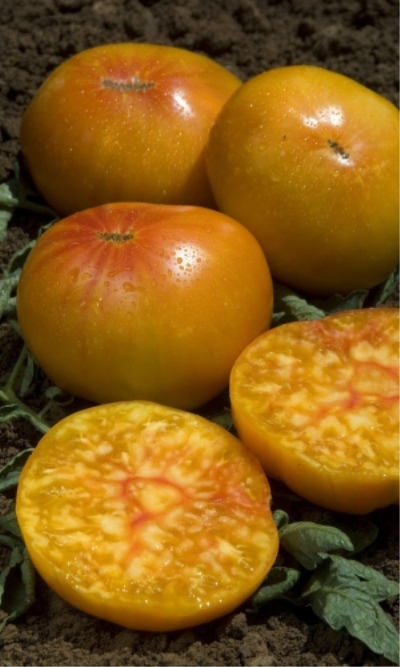
- Authors: USA
- Category: grade
- Growth type: indeterminate
- Appointment: universal
- Ripening period: mid-early
- Ripening time, days: 90-105
- Growing conditions: for open ground, for closed ground
- Transportability: Yes
- Bush size: tall
- Bush height, cm: up to 200
The development of new fruit varieties is already considered traditional. Experts are constantly working to please vegetable growers with crops with unusual properties. One of these varieties is a tomato called Pineapple.
Description of the variety
A variety with an indeterminate type of growth is grown in open or closed ground, depending on the climate of a particular region. Bushes are considered tall. When grown in greenhouses, they grow up to 2 meters, and in open areas the plants do not reach more than 1.5 meters. Fruits are versatile and are suitable both for preparing delicious dishes and for fresh consumption.
The main qualities of the fruit
The exotic tomato gets its name from the color of the fruit. Ripe tomatoes turn bright yellow, reminiscent of a tropical fruit. Large vegetables grow on average up to 250-300 grams, but some specimens can reach 350 grams in weight. The shape is round and slightly flattened. The skin is glossy and smooth, the flesh is fleshy.
Taste characteristics
Ripe fruits have an exquisite and expressive taste. At the beginning, there is a bright sweetness combined with a pleasant sourness. After that, a fruity aftertaste becomes noticeable, delicate and light. Despite the firm flesh, vegetables are easy to cut. To fully appreciate the gastronomic qualities of the crop, you need to wait until they are fully ripe. Harvested at the end of the growing season.
Large tomatoes are most often used for preparing salads, while smaller ones are harvested whole for the winter or cut for snacks or decorating dishes.
Ripening and fruiting
The Pineapple variety is medium early. From 90 to 105 days pass from the day the first shoots appear to the collection of fully ripe tomatoes. Fruiting is long-term. Harvested in summer and autumn, from late July to October. Gardeners note that the bushes bear fruit before the onset of frost.
Yield
The tomato is high-yielding. From one bush, you can get about 5 kilograms of vegetables. One plant forms a maximum of 5 fruit clusters with a different number of ovaries.
The timing of planting seedlings and planting in the ground
This fruit crop is grown only with the help of seedlings. Sowing of seed is carried out taking into account the period of harvesting a ripe crop. The work is carried out in March or April. In regions with a warm climate, plants grow faster and harvest earlier. Most gardeners plant in the first month of spring.
The process of growing pineapple seedlings is no different from germinating standard types of tomatoes. At the beginning, the seeds are sown in one container, and then a pick is carried out. As it develops, the soil is moistened and fed. Before transferring the plants, they are hardened for better adaptation.

Growing tomato seedlings is an extremely important process, because it largely depends on whether the gardener can harvest at all. All aspects must be taken into account, from seedbed preparation to planting in the ground.
Landing scheme
The bushes grow to a height of about two meters, so they need enough free space. A maximum of 2-3 bushes are planted on one square meter of the plot. A heavily thickened planting will negatively affect yields.

Growing and care
When growing the Pineapple variety, stepchildren should be regularly removed. Only in this case it is possible to achieve the formation of large and juicy tomatoes, which will pleasantly surprise you with a rich taste. And also it does not do without regular feeding and compliance with other rules of agricultural technology.
The process of caring for this fruit crop is practically no different from caring for other varieties of tomatoes. Bushes prefer loose and light soil, which easily permits air and oxygen. And also the variety reacts well to organic and complex fertilizers. Pineapple tomato does not tolerate drafts, therefore, when growing vegetables in open areas, you should choose a suitable location.
Do not forget about regular watering. It is necessary to maintain a balance between waterlogging and drying out of the soil so that the bushes are as comfortable as possible. According to gardeners, the bushes have a strong immune system that protects them from common diseases and infections.
To get a regular harvest and enjoy delicious fruits, the following conditions must be met.
Landing holes must be prepared in advance. A spoonful of superphosphate mixed with potassium sulfate is sent to each well. Additional nutrients are used before transplanting seedlings.
In the process of growing, the bushes are formed, leaving no more than three stems.
The maximum number of brushes on one stem should not be more than 4 pieces.
During hot and dry weather, the bushes need to be irrigated more abundantly, preventing the topsoil from drying out.
In the process of forming a crop, plants need a large amount of magnesium, therefore, fertilizers containing this component are used for feeding.
Watering must be combined with hilling. The procedure is carried out after each irrigation.
Damaged shoots and old foliage are regularly removed so that the plant does not waste energy on them.




A plant needs different micronutrients at each stage of growth. All fertilizers can be divided into two groups: mineral and organic.Folk remedies are often used: iodine, yeast, bird droppings, eggshells.
It is important to observe the rate and period of feeding. This also applies to folk remedies and organic fertilizers.



























































































